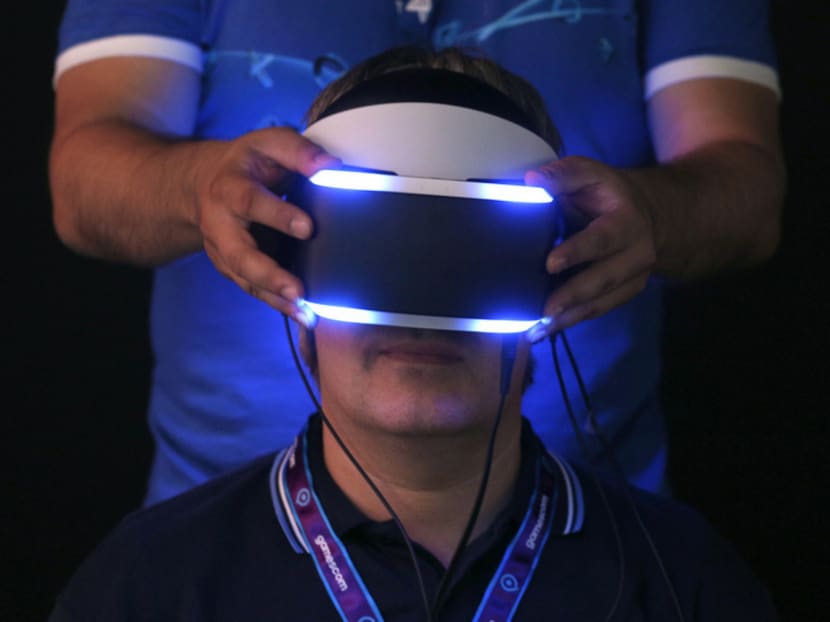Don’t call us augmented — we’re mixed reality, thanks
NEW YORK — Magic Leap chief creative officer Graeme Devine discussed his company’s long-term vision for its technology last week at the Games for Change Festival. The secretive Magic Leap is one of the buzziest companies in a burgeoning industry dedicated to tricking human senses into perceiving computer graphics as real life.

Virtual reality uses a headset to block out old-fashioned reality and replace it with a computerised version. Virtual reality is becoming less popular in favour of ‘augmented’ and ‘mixed’ reality. Photo: Reuters
NEW YORK — Magic Leap chief creative officer Graeme Devine discussed his company’s long-term vision for its technology last week at the Games for Change Festival. The secretive Magic Leap is one of the buzziest companies in a burgeoning industry dedicated to tricking human senses into perceiving computer graphics as real life.
In recent years, the concept has come to be seen as two things: Virtual reality, which uses a headset to block out old-fashioned reality and replace it with a computerised version; and augmented reality, which lays computer graphics over the physical world.
In his presentation, Mr Devine talked up a third flavour: Mixed reality. The major distinction between mixed and augmented — and stick with us here because it gets a bit technical — seems to be that augmented reality is lame, while mixed reality is cool. As Mr Devine spoke, images popped up that purportedly showed what happens when someone Googles augmented reality. One depicted an unimpressive iPhone game; another was an app that shows shoppers what stores are in a mall when you hold up your phone to it. The kind of applications, in other words, that Wired writers delight in mocking. “Mixed reality must be the Wired article we dream of,” said Mr Devine.
In fact, the term is not new at all. Mixed reality emerged in the 1990s as a way to describe all technologies between the real and digital worlds. It has since been used interchangeably with augmented reality, with the latter phrase winning out as the default description circa 2009. But in the last year or so, Magic Leap and Microsoft have become increasingly adamant that mixed reality as represented by products they have in development is fundamentally different.
Some technologists agree there is a distinction, although maybe not an especially big one. One explanation said augmented reality places see-through graphics in the real world, while mixed reality allows for opaque objects, too. Another said the line between augmented and mixed reality lies where virtual objects begin interacting with people and real things. Mr Tomasz Malisiewicz, a deep learning engineer for Magic Leap, recently described mixed reality as a mix of augmented and virtual realities plus some new stuff that will create convincing illusions of objects — an achievement he dubbed the “final frontier”.
Magic Leap may publicly insist that its technology is not and never should be referred to as augmented reality. But the company line is far from consistent. Several Magic Leap employees — with such impressive titles as principal engineer and lead computer vision engineer — describe the company’s technology as augmented reality. In patent filings, Magic Leap has acknowledged that the terms can be used interchangeably.
But that is engineering, not branding. When it comes to selling innovation, augmented reality already seems stale, given how long it has been around without going mainstream. It was one of Time’s Top 10 Tech Trends for 2010, which noted it for the mobile apps and simple graphical overlays. This association with more rudimentary aspects of augmented reality tainted the term and limited the consumer’s imagination and expectation of what it could become one day, said Mr Shawn Cheng, a principal at Vayner Capital. It is also closely associated with Google Glass, which thoroughly flopped as a consumer product after its initial release to developers in 2013.
“I think both Microsoft and Magic Leap are trying to distance themselves from what Google Glass was,” said Mr Philip Ryan, an associate partner at Vivaldi Partners Group,. “They’re trying to say, ‘Hey, mixed reality is going to be totally different.’”
Mr Tom Sepanski of the branding firm Landor Associates said the term mixed reality is shorter, easier to remember and still has a sci-fi feel.
Magic Leap’s recent infatuation with mixed reality is not its first attempt to escape augmented reality. The company initially described its product as cinematic reality. Microsoft skipped straight to the phrase upon introducing its HoloLens headset to developers last year.
People initially referred to the HoloLens as augmented reality, said Gartner analyst Brian Blau. But the company has insisted that doing so is wrong. Microsoft thinks it can make the HoloLens seem like “something potentially sexier, an update to augmented reality”, he said.
None of these products are available yet in stores. So fighting over what to call the technology seems silly when no one is listening, said Mr Ryan. Customers will end up choosing whatever nomenclature they like. He said: “It’s really just engineers talking to themselves right now.” BLOOMBERG





